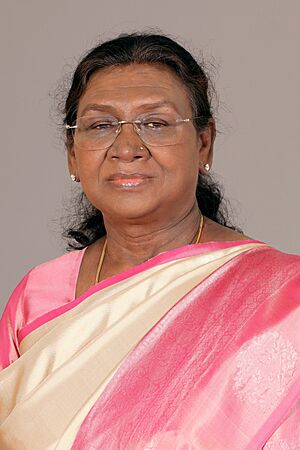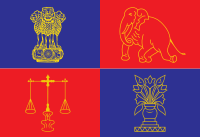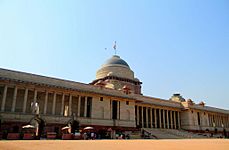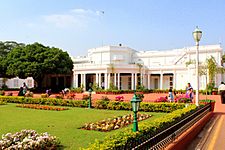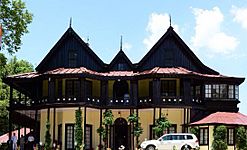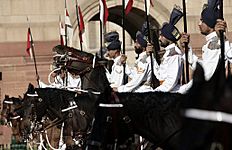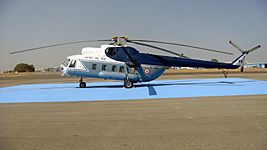President of India facts for kids
Quick facts for kids President of the Republic of India |
|
|---|---|

|
|

Logo of the President of India
|
|
| Head of state of the Republic of India Executive branch of the Indian Government |
|
| Style |
|
| Abbreviation | POI |
| Residence | Rashtrapati Bhavan |
| Seat | New Delhi, Delhi, India |
| Appointer | Electoral College of India |
| Term length | Five years,
no restriction on renewal
|
| Constituting instrument | Constitution of India (1950) |
| Precursor | Monarch of India and his representative the Governor-General of India |
| Formation | 26 January 1950 |
| First holder | Rajendra Prasad |
| Deputy | Vice President of India |
| Salary | • ₹6,000,000 (US$100,000) (annually) |
The President of India (in Hindi: Bhārata kē Rāṣṭrapati) is the head of state for the Republic of India. Think of the president as the country's top representative. They are also the first citizen of India and the supreme commander of the Indian Armed Forces. Droupadi Murmu became the 15th president on 25 July 2022.
The role of president was created when India's Constitution began on 26 January 1950. This was when India officially became a republic. The president is chosen through an indirect election process. This means citizens don't vote for them directly. Instead, an electoral college votes. This college includes members from both houses of the Parliament of India and the elected members of state assemblies.
The president is the official head of the government's executive branch. However, in reality, the prime minister and their team (the Council of Ministers) use most of these powers. The president must follow the advice of this council. They also make sure that decisions from the Supreme Court are followed.
Contents
- How the President's Role Began
- President's Responsibilities and Powers
- How the President is Chosen
- Salary and Benefits
- Removing the President (Impeachment)
- What Happens if the President's Office is Empty?
- President vs. Chief Justice
- President vs. Prime Minister
- Important Presidential Actions in the Past
- See also
How the President's Role Began
India became independent from British rule on 15 August 1947. At first, it was a dominion, meaning it still had the British King as its head. A governor-general represented the King in India.
After independence, a special group called the Constituent Assembly of India worked to write a new constitution. This group was led by B. R. Ambedkar. The Constitution of India was finished on 26 November 1949. It officially started on 26 January 1950, making India a republic. The new role of President of India replaced the King and Governor-General. Rajendra Prasad was the first president.
The Indian Constitution gives the president the job of protecting and defending the Constitution and its laws. Any new law or action by the government only becomes official after the president approves it. The president must not approve anything that goes against the Constitution. They are the main defender of the Constitution.
President's Responsibilities and Powers
The president's main job is to protect and defend the Constitution and the laws of India. This is part of their oath. The president oversees all independent parts of the government. All their actions must follow the Constitution.
Legislative Powers
The president is the head of the Parliament of India. This means they help with the lawmaking process.
- The president calls meetings for both houses of parliament: the Lok Sabha and Rajya Sabha. They can also end these meetings.
- They can even dissolve the Lok Sabha, which means ending its term early.
- The president opens parliament sessions by giving a speech. This happens after general elections and at the start of the first session each year. This speech usually explains the new plans of the government.
All bills (proposed laws) passed by parliament become laws only after the president signs them. When a bill is given to the president, they can:
- Sign the bill, making it a law.
- Refuse to sign it.
- Send the bill back to parliament for them to think about it again. This cannot be done for money bills. If parliament sends the bill back to the president again, even with no changes, the president must sign it.
The president can also issue special orders called ordinances. These are like temporary laws. They are used when parliament is not meeting and there is an urgent need for a new rule. These ordinances are valid for six weeks after parliament meets again, unless parliament approves them earlier. The president should only issue ordinances when it's truly necessary.
Executive Powers
The president is the head of the executive branch of the government. They carry out their duties directly or through other officials. The Union Cabinet, led by the prime minister, helps and advises the president. The president must ensure that all duties are performed according to the Constitution. They must also make sure that decisions from the Supreme Court are followed.
Judicial Powers
The president's main duty is to protect the Constitution and the laws of India.
- The president appoints the Chief Justice of India and other judges. They do this based on the advice of the Chief Justice.
- Judges can be removed only with a two-thirds vote from both houses of parliament.
- The president also appoints the Attorney-General for India, who is the government's chief legal adviser.
- If there is an important legal question, the president can ask the Supreme Court for its advice.
Appointment Powers
The president makes many important appointments:
- They appoint the prime minister. This is usually the person who has the most support in the Lok Sabha.
- The president then appoints other ministers based on the prime minister's advice.
- They appoint 12 members to the Rajya Sabha. These members are chosen for their special knowledge in areas like literature, science, art, and social service.
- Governors of states are also appointed by the president.
- Other key appointments include:
- Judges of the Supreme Court of India and High Courts.
- The Chief Minister of Delhi.
- The Comptroller and Auditor General of India.
- The Chief Election Commissioner and other Election Commissioners.
- The chairman and members of the Union Public Service Commission.
- Ambassadors and High Commissioners to other countries.
- Officers of the All India Services (like IAS and IPS).
Financial Powers
The president has important roles in the country's finances:
- A bill about money can only be introduced in parliament with the president's approval.
- The president presents the country's annual budget to parliament.
- They can take money from the Contingency Fund of India for unexpected expenses.
- Every five years, the president sets up a Finance Commission. This group suggests how taxes should be shared between the central government and the states.
Diplomatic Powers
The president represents India on the world stage:
- All international agreements and treaties are made in the president's name. However, the prime minister and their Cabinet usually handle these talks.
- The president also sends and receives diplomats from other countries.
- The president is considered the first citizen of India.
Military Powers
The president is the supreme commander of the Indian Armed Forces.
- Only the president can declare war or make peace. They do this based on the advice of the prime minister and the Council of Ministers.
- All important treaties and contracts are made in the president's name.
Pardoning Powers
The president has the power to grant pardons. This means they can forgive or reduce punishments in certain situations:
- For crimes against Union law.
- For punishments given by a military court.
- For a death sentence.
The president's decisions on pardons are independent. However, they usually act on the advice of the prime minister and the Cabinet.
Emergency Powers
The president can declare three types of emergencies:
- National Emergency
- State Emergency
- Financial Emergency
National Emergency
A national emergency can be declared if there is a war, armed rebellion, or an attack from another country. This can cover all of India or just a part of it. India has had national emergencies in 1962 (during the Sino-Indian War), 1971 (during the Indo-Pakistani War of 1971), and from 1975 to 1977.
The president can declare this emergency only if the Cabinet, led by the prime minister, asks them to in writing. Parliament must approve this declaration with a two-thirds majority within one month. An emergency can last for six months and can be extended with more parliamentary approvals. There is no maximum time limit.
During a national emergency, some Fundamental Rights of citizens can be suspended. However, the Right to Life and Personal Liberty (Article 21) cannot be suspended. The president can also make laws on subjects usually handled by state governments. The term of the Lok Sabha can be extended by up to one year.
State Emergency
If the president believes a state government cannot follow the Constitution, they can declare a state of emergency in that state. This is often called "President's rule." Parliament must approve this within two months.
A state emergency can last from six months up to three years. It needs parliamentary approval every six months. During this time, the president takes over the state's executive work. The state governor runs the state in the president's name. The state's assembly can be dissolved or put on hold. Parliament can then make laws for that state.
Financial Emergency
The president can declare a financial emergency if the country's financial stability or credit is in danger. This has never happened in India. Parliament must approve this within two months.
If a financial emergency is declared, the president can reduce the salaries of all government officials, including judges. All money bills passed by state assemblies must be sent to the president for approval.
How the President is Chosen
Who Can Be President?
To become president, a person must:
- Be a citizen of India.
- Be 35 years old or older.
- Be qualified to become a member of the Lok Sabha.
A person cannot be president if they hold any "office of profit" under the government. This means they cannot have a job that gives them a salary or benefits from the government. However, some people are allowed to be candidates:
- The current vice president.
- A state governor.
- A minister (including the prime minister or chief ministers).
If a vice president, governor, or minister is elected president, they leave their old job when they start as president. A member of parliament or a state assembly can also run. If they win, they give up their seat in parliament or the assembly. A person can be re-elected as president any number of times.
To be nominated for president, a candidate needs at least 50 people who will propose their name and 50 people who will second it. These people must be electors (voters) in the presidential election.
When is the Election Held?
The president holds office for five years. The election for a new president must be completed before the current president's term ends. If the president's office becomes vacant due to death, resignation, or removal, a new election must be held as soon as possible, but no later than six months. The new president will then serve a full five-year term.
If the election cannot be completed in time, the current president continues to hold office until their successor takes over.
Election Process
When the president's office becomes vacant, a new president is chosen by an electoral college. This college includes:
- Elected members of both houses of Parliament of India (MPs).
- Elected members of the State Legislative Assemblies (Vidhan Sabha) of all states.
- Elected members of the legislative assemblies of union territories with legislatures (Delhi, Jammu and Kashmir, and Puducherry).
The election uses a special method called instant-runoff voting. Voting is done by secret ballot. Each elector (voter) casts a different number of votes. The number of votes depends on the population of their state and the number of legislators in that state. Members of parliament all have the same number of votes. While MPs and MLAs vote, they usually vote for the candidate their party supports.
Oath or Affirmation
Before taking office, the president must take an oath. This is done in front of the Chief Justice of India (or the senior-most judge of the Supreme Court if the Chief Justice is absent). The oath is to protect, preserve, and defend the Constitution and the law.
The president says: "I, (name), do swear in the name of God (or solemnly affirm) that I will faithfully execute the office of President (or discharge the functions of the President) of the Republic of India, and will to the best of my ability preserve, protect and defend the Constitution and the law, and that I will devote myself to the service and well-being of the people of the Republic of India."
Salary and Benefits
The president of India receives a salary of ₹5 lakh (US$8,500) per month. The government also provides an annual budget of ₹225 million (US$3.8 million) for the president's expenses and upkeep.
The official residence of the president is Rashtrapati Bhavan in New Delhi. It is the largest presidential palace in the world. The president also has official retreat residences: Rashtrapati Nilayam in Hyderabad and Retreat Building in Shimla.
The president's official car is a special, heavily armored Mercedes Benz S600 Pullman Guard. Former presidents and their spouses also receive pensions, furnished homes, security, and other benefits.
- Presidential amenities
-
Rashtrapati Bhavan, the official residence of the president, located in New Delhi
-
Rashtrapati Nilayam is the official retreat of the president located in Hyderabad.
-
The Retreat Building is the official summer retreat of the president located in Shimla.
-
The President's Bodyguards is an elite household cavalry regiment of the Indian Army.
-
VIP B777 with call sign Air India One (INDIA 1) is used for international travels by the President.
-
Indian Air Force's BBJ 737 with call sign Air India One (INDIA 1) is used for domestic travels by the President.
Removing the President (Impeachment)
The Supreme Court looks into any questions or problems that come up during a president's election. The Supreme Court can remove a president if there were problems with the election or if the president no longer meets the requirements to be a member of the Lok Sabha.
The president can also be removed from office before their term ends through a process called impeachment. This happens if they violate the Constitution of India. The impeachment process can start in either house of the Parliament of India.
- One house starts by making charges against the president.
- These charges must be signed by at least one-quarter of the members of that house.
- The notice is sent to the president, and 14 days later, it is discussed.
- If two-thirds of the members of the first house vote to impeach, the charges are sent to the other house.
- The second house then investigates the charges. The president has the right to defend themselves during this investigation.
- If the second house also approves the charges with a two-thirds majority, the president is impeached. They are then considered to have left office from that date.
No president in India has ever faced impeachment proceedings. While a president cannot be questioned in court during their term, any unconstitutional decisions they make can be declared invalid by the courts. After leaving office, a former president can be prosecuted for any illegal actions committed during their time as president.
What Happens if the President's Office is Empty?
The president's office can become empty in these situations:
- When their five-year term ends.
- If they pass away.
- If they resign.
- If they are removed by impeachment.
If the office becomes empty for any reason other than the term ending, the vice-president of India takes over the president's duties. The vice president acts as president until a new president is elected. If the president is unable to act due to absence or illness, the vice president performs their duties until the president returns.
When the vice president acts as president, they have all the powers and benefits of the president. They do not act as the Chairperson of the Rajya Sabha during this time.
If both the president and vice president's offices are empty at the same time (due to removal, death, or resignation), the Chief Justice of India takes over as acting president. If the Chief Justice is not available, the senior-most judge of the Supreme Court of India takes the role. This continues until a new president is elected or a new vice president starts acting as president. For example, in 1969, when President Zakir Husain passed away, Vice-President V. V. Giri became acting president. Later, V.V. Giri resigned to run for president. Then, the Chief Justice of India, Justice Mohammad Hidayatullah, served as acting president until the next president was elected.
President vs. Chief Justice
The president and the Chief Justice of India both have important roles in upholding the Constitution.
- The president's oath is to protect the Constitution and the law. The Chief Justice also takes an oath to uphold the Constitution and laws.
- The president takes their oath in front of the Chief Justice. The Chief Justice takes their oath in front of the president.
- The president can be impeached by parliament for violating the Constitution. Judges can be removed by parliament for proven misbehavior or inability.
- The Supreme Court can declare a president's election invalid, which removes them from office. The president cannot remove judges without the impeachment process.
- The president is the head of parliament, the executive, and the armed forces. They are responsible for ensuring states follow the Constitution. The Supreme Court can overturn unconstitutional actions by the government or laws passed by parliament, but only after a fair trial.
- The president's main job is to prevent unconstitutional decisions by the government or parliament by refusing to sign laws. They are the first line of defense for the Constitution.
- The president has some legal protection during their term for their official actions. However, they can face legal action for unconstitutional acts after their term ends. Judges also have some protection, but their verdicts can be reviewed by higher courts.
President vs. Prime Minister
The president and prime minister have different but important roles in India's government.
- The president's oath is to protect the Constitution. The prime minister swears loyalty to the Constitution and promises to serve all people fairly.
- The president takes their oath in front of the Chief Justice. The prime minister takes their oath in front of the president.
- The president is chosen indirectly by an electoral college. The prime minister is chosen by the political party or group that wins the most seats in the Lok Sabha in direct elections.
- The president can be impeached by parliament for violating the Constitution. The prime minister steps down if they lose the support of the majority in the Lok Sabha.
- The Supreme Court can remove the president if their election was unfair or if they don't meet the qualifications. This can also happen to the prime minister and other ministers.
- The president is the head of state. The prime minister and the Union Cabinet are responsible for the day-to-day running of the government.
- The president's main role is to prevent unconstitutional decisions by the government or parliament. The prime minister and Cabinet advise the president. The prime minister must inform the president about all government decisions and proposed laws.
- The president has some legal protection for their actions during their term. The Union Cabinet also has some legal protection for the advice they give to the president.
Important Presidential Actions in the Past
The president's role has changed over time. Presidents have sometimes stepped in to influence government and lawmaking.
Proving Majority in Parliament
In 1979, Prime Minister Charan Singh did not have enough support in parliament. He did not ask the president to call a parliament meeting. Since then, presidents have been careful to ask new prime ministers to prove their support in parliament within a few weeks. During this time, prime ministers usually cannot make big policy decisions.
Proof of Majority to Form a Government
Since the 1990s, elections often resulted in no single party having a clear majority. In these cases, presidents have asked prime ministerial candidates to show proof of their support before being invited to form the government. This usually involves getting letters and signatures from MPs who support them.
Vetoing a Bill
The Indian Constitution does not set a time limit for the president to sign or refuse a bill. This means the president can use a "pocket veto" by not taking any action for a long time. In 1986, President Zail Singh used this on the Postal Bill. He felt the bill gave the government too much power to check mail.
Explaining Decisions
In the late 1990s, President K. R. Narayanan started explaining his decisions to the public. He would issue "Rashtrapati Bhavan Communiqués" to explain why he made certain choices when using his special powers.
Returning a Bill
The president can send a bill back to parliament for reconsideration, but only once. If parliament sends the bill back again, with or without changes, the president must sign it. In 2006, President A. P. J. Abdul Kalam sent back a bill about "offices of profit." This bill would have allowed certain people to be MPs even if they held government jobs. Parliament sent the bill back without changes, and Kalam signed it after 17 days.
Removing State Governors
President Pranab Mukherjee removed the governor of Arunachal Pradesh, Jyoti Prasad Rajkhowa. This happened after the Supreme Court ruled that the governor's actions were unconstitutional.
See also
 In Spanish: Presidente de India para niños
In Spanish: Presidente de India para niños


